Restoring bathtubs with liquid acrylic: how to properly coat an old bathtub with new enamel
One of the most important advantages of cast iron baths is their durability.Such plumbing can serve faithfully for several decades, maintaining its technical characteristics. However, over time, the bath may lose its original whiteness.
Agree, not everyone is ready to get rid of high-quality cast iron in favor of plastic or steel counterparts. An alternative solution is to restore the bathtub with liquid acrylic at home. The work is simple, but requires compliance with some nuances.
We will tell you how to choose high-quality acrylic for a bathtub, identify manufacturers you can trust, and also describe in detail the sequence of updating old plumbing fixtures. The information provided will help home craftsmen restore the former gloss of the coating and extend the service life of the font.
The content of the article:
- Which acrylic to choose for the bathroom?
- Fake poured acrylic
- Do-it-yourself bathtub restoration
- Materials and tools used
- Preparing the bathroom
- Cleaning the bowl of a restored bathtub
- Washing and drying plumbing fixtures
- Laying flooring and degreasing the bathtub
- Preparing liquid acrylic for application
- Casting acrylic enamel into a bathtub
- How to dry a free-flowing bathtub
- It's time to install the harness
- Conclusions and useful video on the topic
Which acrylic to choose for the bathroom?
First, let's understand the terms. The domestic market for acrylic products designed to restore the bowl of a well-used bathtub is full of brands. "Plastol", "Yarli", "Standard", "Stakryl", Finnacryl and even "Eco-enamel" - there are many names.
All enamels are two-component, approximately similar in price - 1400-1500 rubles. for a 3.4 kg jar, which is enough to cover a one and a half meter container with acrylic.
All paints and varnishes of the “liquid acrylic” group, incl.Each brand listed above carries out bathtub restoration. The walls of the sanitary bowl are poured with two-component acrylic, which polymerizes and hardens, turning into a smooth and durable coating within a day.
The self-leveling bath is not a commercial product, but a painting technology. It consists of pouring a new paint coating over the existing worn-out layer of paint. Manufacturers are developing their own acrylic-enamel series of restoration materials for bathtubs, the formulas of which are carefully hidden from competing enterprises.
Among masters who restore bathtub containers and their clients, liquid acrylic of any brand is usually called glass acrylic. Although “Stakril” is a brand of the St. Petersburg enterprise “Ekolor”, popular rumor assigns the name of its brand to all liquid acrylic compositions.

set of three products - liquid acrylic, hardener and degreaser
The reason is simple: “Stacryl” was the first widely advertised polymer material for bathroom restoration, which is why it became a household name for liquid acrylics in general. The technically correct name for acrylic-based bath paints is “self-leveling acrylic.”
Therefore, when choosing an acrylic bathroom paint, you need to name a specific brand of product, and not “you have acrylic.”
Now about the quality. Manufacturers of bulk acrylics LLC "Ekolor" (brand "Stakril"), LLC "Plastol", LLC "Ekovanna" and CJSC NPK "YarLi" (brand "Yarli") are the largest enterprises in Russia.
It is their products that are recognized as the highest quality on the domestic market.To independently repair the enamel coating of a bathroom, you should choose one of the mentioned brands.
In addition to having their own technical laboratories, many years of experience in the production and distribution of products throughout Russia, the products of all four listed manufacturers of self-leveling acrylic have one more advantage - they are trying to imitate it.
On the one hand, this is a plus, because it makes no sense to produce counterfeits under a bad brand and product. However, there is also an obvious disadvantage - the likelihood of purchasing a low-quality product.
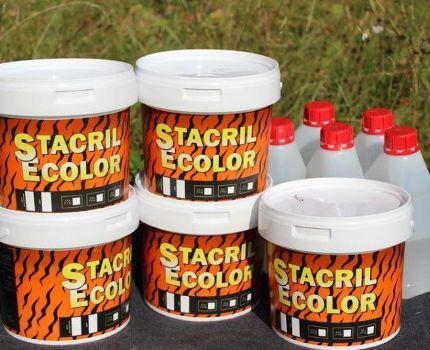
acrylic containers mean only one thing - fake
Fake poured acrylic
There are more and more homeowners interested in restoring bathtub enamel every year. Following the growing demand, manufacturers of self-leveling acrylic are expanding production and improving a series of acrylic enamels for plumbing equipment. But a variety of types of “entrepreneurs” strive to make money from this paintwork.
First type: small companies intending to fill a niche in the local market. Before reaching consumers with the liquid acrylic of their production, they buy the products of large companies in bulk, bottle them in their own containers and sell them under their brand.
Having attracted buyers to the “new product” after several months of sales, such companies begin to bottle not other people’s products, but their own. Without sufficient funds and equipment, these companies develop acrylic technologies with “optimal characteristics”, using raw materials from dubious suppliers.
Second type: similar enterprises also purchase large quantities of liquid acrylic with hardener from well-known manufacturers, but only in original containers with a label.
Next, each container is opened, a portion of the product is poured out and the solvent is added. Diluted acrylic is taken to the market and sold under the guise of the original product.
If liquid acrylic is diluted with a solvent, its performance characteristics will sharply decrease. This coating does not adhere well to the bathtub; it is too liquid and brittle. After a short period of time, the painted bathtub turns yellow and the enamel peels off. Please note that liquid acrylic cannot be diluted with anything other than the included hardener.
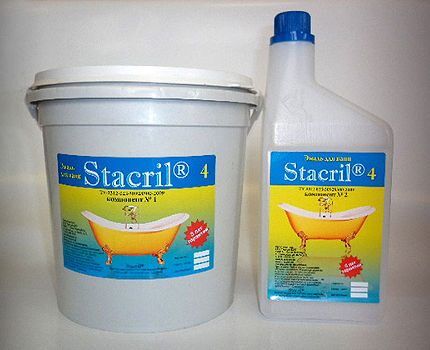
Third type: a small enterprise purchases several containers of liquid acrylic from well-known brands and tries to copy them. Having developed a very approximate formula and technological process, this company purchases the cheapest possible raw materials. The production of products with bright labels and names begins.
The manufacturer does not make any attempts to popularize a specific product brand, because The product is of low quality and soon there will be no buyers for it. However, the company often changes the shape of the containers and the name of the product, thereby restarting its sales again and again. Such liquid acrylic cannot be called high-quality, only cheap.
In regional markets of Russia, counterfeits of acrylic enamels most often appear "Stakryl", "Ekovanna" And "Plastol". To interfere with imitators, manufacturers of these brands periodically change the color design and shape of cans with liquid acrylic and a hardener.
You can find out the actual type of the brand you are interested in by visiting the manufacturer’s website and studying the product description page.
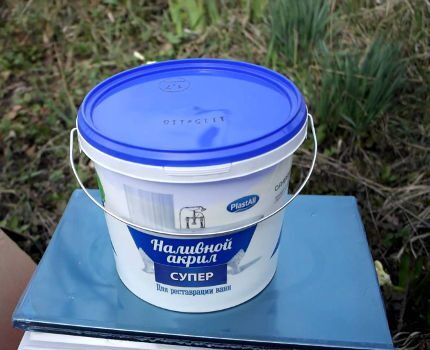
this is an original product. The seal on the lid is intact, which means acrylic was not cast from this bucket
However, the goods are distributed differently in different regions - some batches are sold out for months. Within the factory warranty period and subject to proper storage procedures, packaged liquid acrylic is completely suitable for use.
Let's assume that you are offered a brand product, say, "Plastol" - the expiration date is fine, but the bucket is designed in an outdated design of the manufacturer. The seller explains: the batch of acrylic arrived before the Plastol company changed the design of the cans, but otherwise the product is original.
Inspect the bucket of acrylic and the bottle of hardener:
- Marking on the lid. Plastol prints the batch number on the lids of the cans using laser lithography. Manufacturers of “Ekovanna” and “Stakril” mark the lids with adhesive labels with the batch number printed on them. There should be no other labels on the lids.
- Cap color. Be sure to make sure that the color of the caps on the jar and bottle matches the image of the product on the manufacturer’s website.
- Brand logo. Labels on the sides of cans and bottles must contain the actual manufacturer's logo;
- The correctness of the sticker. Labels on the sides of acrylic cans and on solvent bottles are applied by the original manufacturer using in-line machine adhesive. Distortions and crumpled areas mean that the label was affixed by hand and is a fake;
- Integrity of the filling. The plastic fuse on the caps of the bottle with hardener and the jar of liquid acrylic must be intact (not broken).
The caps of bottles containing liquid hardener are usually signed with a marker when releasing a batch - this is normal. There is not enough space on the bottle cap to fully print or place a label.
Additional information about the types of self-leveling acrylic, as well as tips for choosing restoration enamel, are given in the articles:
- How to choose enamel for bath restoration: a comparative review of popular products
- Self-leveling acrylic for bathtubs: seven popular compositions for restoration + what to look for when purchasing
Do-it-yourself bathtub restoration
Restoring the enamel coating of a bathtub bowl yourself will save you an average of 1,200-1,700 rubles (that’s what craftsmen charge). However, you need to evaluate your skills before starting work: a minimum of experience in assembling plumbing fixtures and performing painting work is essential.
The process of preparing the bath and casting a new coating requires care, otherwise long-term quality cannot be achieved.
Materials and tools used
So, you have purchased a sufficient amount of liquid acrylic and hardener. Please note: you need enough acrylic enamel to finish your bathroom. Soviet-made models have a length of 1400-1700 mm, European products are made with a maximum length of 1800 mm.
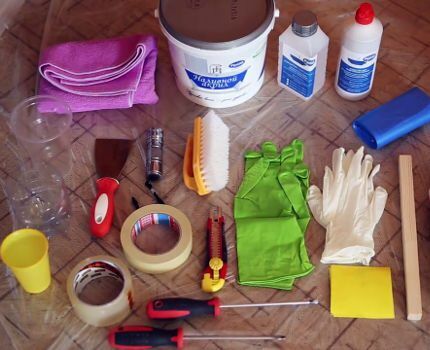
Carefully evaluate your readiness for work. At the stripping stage, stopping work is still permissible, but after
You can’t stop mixing acrylic with hardener
Manufacturers indicate on containers with liquid acrylic the length of the bath for which the calibrated volume of material is calculated. Measure the length of the bowl along its center, from the edge of one side to the edge of the other. If your object of work is longer than the size indicated on the jar of acrylic, you need to buy more material. It is important.
For enameling using the “fill bath” technology, the following tools and materials are needed:
- Kneading device. When manually mixing acrylic with hardener and color, you will need a wooden or plastic spatula - blade width 40-60 mm, handle length 500-600 mm. Mixing with a drill and mixer should not be done, only by hand.
- Sandpaper - 5 pieces. (230*280 mm). You need sandpaper grade P60 (according to ISO-6344) or 25-H (according to GOST 3647-80) on a fabric basis, waterproof.
- Solvent No. 646 or 647. It will be required to degrease the surface of the bathtub bowl after sanding and washing it.
- Putty knife – width 100 mm.A metal spatula will do, but only a new one, without dirt or rusty streaks.
- Adhesive tape - tape, 50 mm wide. You will need two types of tape - masking tape (on paper) and fastening tape (on film).
- Wallpaper knife. Necessary for cutting tape and trimming dried acrylic streaks from the bathroom drain hole before reinstalling the drain and overflow.
- Screwdrivers - straight and cross to remove the drain-overflow siphon. A gas wrench may also be required;
- Stool. It is much more convenient to mix acrylic with a hardener and put the prepared enamel into a container for application if you place a bucket of liquid acrylic on a stool.
In principle, to prepare the walls and bottom of the bathtub for casting with acrylic, manual processing with sandpaper is sufficient. But only if it has not been painted with anything before, i.e. Factory enamel on the surface. Otherwise, you will need to clean it with a drill or grinder.
To remove secondary enamel, the drill requires a Velcro attachment and sanding wheels of grade P40 (or 40-H); for an angle grinder, grinding wheels of the same brand are needed.
Required protective equipment:
- Work clothes – trousers, long sleeve shirt or jacket. Drops of acrylic on the skin are not dangerous, but once they dry, they are quite difficult to remove.
- Headdress - at least a headscarf. Hair should not get on the enamel coating during the casting process.
- Respirator – at least a “petal”. Cleaning the bathtub will cause a strong release of dust; you should not breathe such air.
- Disposable latex gloves. Hands must be protected from contact with liquid acrylic.
You will need newspaper sheets or PVC film to cover and hang the surfaces around the restored plumbing fixtures.We remind you: drops of cured acrylic spilled during the restoration process are very difficult to remove.
Preparing the bathroom
Collect and remove items usually found in this room: toothbrushes, towels, laundry basket, other cosmetic and hygiene items. The shower curtain should be removed, and if possible, the curtain bar should also be removed.
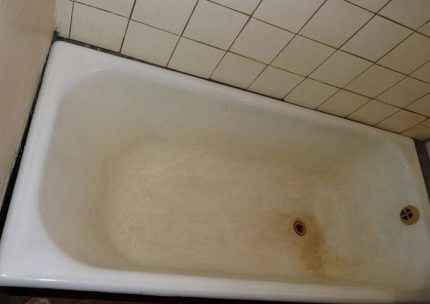
If the sink cabinet and washing machine are located close to the side of the plumbing, they need to be moved or, if it is impossible, removed completely. A 100 mm gap between the bathtub wall and any nearby object is sufficient.
To prevent dust particles of old enamel from passing into neighboring rooms, the ventilation hole in the bathroom is covered with PVC film. It will not be possible to open it until the end of the restoration work.
If there is a non-removable geyser in the bathroom, as well as other objects and appliances that can be damaged due to excess dust, it is necessary to cover them with sheets of newspaper or plastic film secured with tape.
Cleaning the bowl of a restored bathtub
The inner surface of the bowl must be thoroughly sanded by hand, with a drill with a special attachment, or with a grinder equipped with a grinding disc.
For manual sanding, use a special sandpaper attachment or wrap it around a short piece of wood of a suitable width.
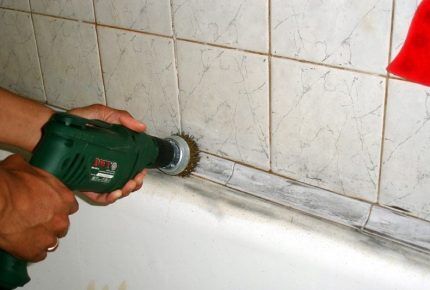
The entire enameled surface of the bathtub should be cleaned, paying special attention to the bottom, the areas where the bottom meets the walls and their bends. When cleaning, perform circular and horizontal movements, alternating them. Finally, you need to walk over all surfaces in a circular motion.
Purpose of cleaning: to remove rust and form a shallow (no more than 0.5 mm) relief on its inner surface. Such irregularities will ensure reliable fastening of liquid acrylic and will not cause its overuse.
If you previously tried to restore the bathtub by painting, you will need to completely remove this layer of enamel. We remind you that you should not try to completely remove the factory enamel from the bathtub - there is no need for this.
Cleaning is considered complete if the entire internal surface (including the sides) has become slightly rough, without chips or protruding edges of the factory enamel coating.
Washing and drying plumbing fixtures
After cleaning with hand-held electrical appliances, the air in the room will be very dusty. To remove dust, run hot tap water over the bathtub and the tiled wall around it. The hotter the water, the more steam it produces, the better.
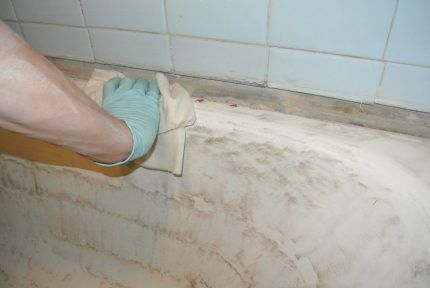
Remove dust particles as thoroughly as possible from the tiles on the walls around the bowl, from the shower curtain rail, from the surfaces of the sink, from the washing machine, from the faucet and other objects.It is strictly forbidden to leave dust - the slightest draft and it will fly up, depositing on the freshly applied acrylic coating.
Completely clean the surface of any dust particles that have accumulated after cleaning. Rinse the bathtub with water from a hose, use liquid detergents without abrasive particles. Please note: the cleaner the bowl, the more firmly the acrylic enamel will stick to it.
Once you have finished rinsing, completely close the water taps on the mixer. Remove the shower hose (there will be a gasket there, don’t lose it), put it in another room.
Not a single drop of water should end up in the bath. If the faucet is leaking, wrap it with plastic film or, as a last resort, turn off the water supply using shut-off valves on the water pipes.
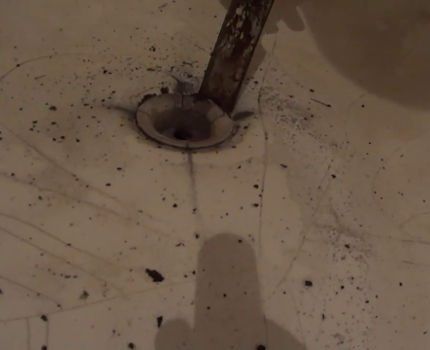
Remove the drain-overflow, acting carefully - after painting it must be put back. Under the drain hole you need to install a suitable container with a volume of at least half a liter, into which excess liquid acrylic will be drained during the process of pouring the enamel composition.
Turn up the hole in the sewer pipe elbow where the drain pipe from the drain-overflow was previously inserted. Otherwise, water may leak when draining through the kitchen sink.
Wipe the bowl, tiled walls, above the bathtub and adjacent surfaces dry. After washing, there will be drops of water on them. Use a lint-free cotton cloth and, if possible, a hair dryer.
Dry especially carefully the areas adjacent to the sides of the bathtub, drops of water always remain there.If the cracks in these areas are difficult to dry, use a hair dryer designed for drying hair.
Laying flooring and degreasing the bathtub
The process of applying acrylic coating is accompanied by smudges from the sides. You will need to lay newspapers and polymer film on the floor - lay it overlapping, overlapping the edges. It is very difficult to remove acrylic drops from the floor, so try to reliably block their access to the floor covering.
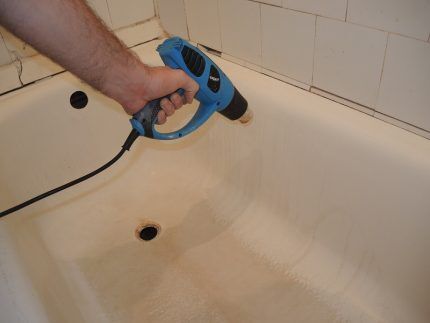
The walls adjacent to the sides should also be covered with paper and tape, first placing masking tape along each side. If the wide side has a sliding screen, it is necessary to dismantle it entirely. If the screen is tiled, cover it with newspapers (film).
If there are deep chips on the enamel of plumbing fixtures, they must be thoroughly puttied. Use quick-drying auto putty - auto enamel stores sell it. To work with putty, use the manufacturer's instructions indicated on the packaging.
The last stage of preparation for enameling is degreasing the surfaces. Wet a lint-free rag with solvent and wipe down the entire bathtub as thoroughly as possible. All that remains is to collect dust particles and lint remaining after wiping and degreasing.
With an open, dry, clean hand, walk along the sides and sides of the bathtub, discarding debris to the bottom. Then use your hand to push debris from the bottom into the drain hole.
Preparing liquid acrylic for application
Before mixing acrylic enamel, containers with components should be kept warm for a day at room temperature.The best operating temperature is 24-26°C.
If at the time of acrylic casting work the room is cooler (less than 20°C), you need to heat the mixture by placing it in a bowl of warm water. Heat liquid acrylic to a temperature of more than 26°C should not be.
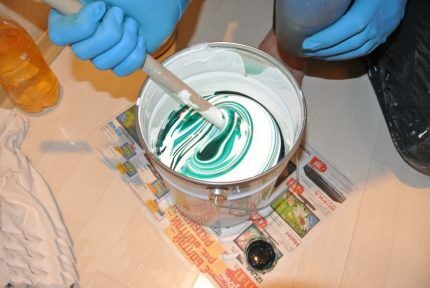
Open the bucket of acrylic, the bottle of hardener (using latex gloves!), and pour the hardener into the jar of acrylic. Next, mix with a wooden (plastic) spatula, following the manufacturer's instructions. Please note that they give different times for the mixing process.
For example, “Plastol Premium” must be stirred for 12 minutes, then allowed to settle for 3 minutes and smoothly stirred again for 3 minutes. And “Stakryl” after ten minutes of stirring and three minutes of settling can be poured onto the walls of the bath.
To tint acrylic enamel, after mixing the composition for three minutes, pour drops of color into it without stopping mixing. But no more than 5 drops - the acrylic mass will thicken and it will be impossible to work with it. Saturated color for decorative protective enamel is impossible, only light shades.
When stirring, perform circular movements, periodically changing their direction. While mixing, run a spatula along the sides and bottom of the bucket, removing unreacted acrylic and combining it with the hardener.
Take your time, move the spatula smoothly - air bubbles are unacceptable. You cannot use a mixer on a drill, because... the mixture will include a lot of air.
Check the time required for mixing strictly by the clock dial or smartphone screen.The minutes indicated by the manufacturer for the process of preparing the mixture must be strictly observed.
Casting acrylic enamel into a bathtub
The bucket of liquid acrylic is too large to pour the enamel directly from. You need to prepare a small plastic container, for example the same hardener bottle. Cut it in half and wipe dry with a rag.
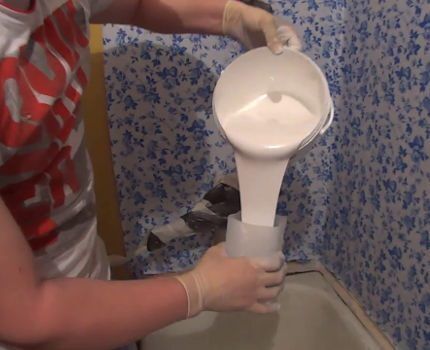
After 40-60 minutes from the moment mixing is completed, the acrylic mixture will begin to harden and will become impossible to work with. Don't waste your time. Place the jar of acrylic in the bathtub, next to the prepared container for casting. Fill the latter with acrylic mass and begin application.
Stand firmly next to the bathtub so that you can reach any edge of it without changing the position of your legs. Do not place your feet directly at the edge of the side - acrylic will get on them.
The first stage - sides
Start pouring liquid acrylic from the far left edge of the bathtub bowl, gradually moving your hand to the right. The sides should be filled with so much enamel that it completely covers the surfaces and re-filling is not required. Add acrylic to the container as it becomes empty.
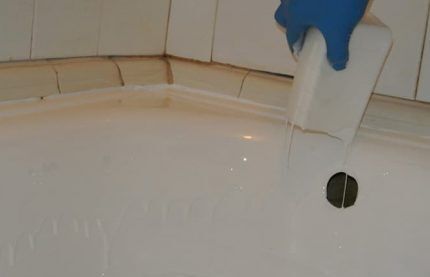
Be careful - if you pour too much acrylic, it will flow from the sides onto the floor and there may not be enough enamel for the entire bath. If there are empty areas on the sides, apply the composition to a spatula and use it to cover the unfilled areas.
Second stage - walls
They need to be coated with the compound in two passes.Make the first pass from the edge of the back of the bathtub bowl (the area where the wall becomes completely vertical) in the direction from left to right. Don’t skimp on the enamel composition; the excess will flow to the bottom, but it still needs to be painted.
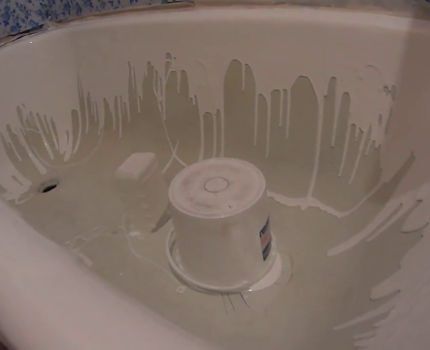
so that the moving residues of acrylic enamel flow out on their own
The first pass along the walls will cover them almost halfway. Be careful - drops from the filling container should not fall on surfaces already coated with the composition. Otherwise, drips will be visible.
Spill especially a lot of acrylic on the back of the bathtub, it is less vertical and the composition will drain slowly. Remove the bucket of acrylic from the container being treated.
Make the second pass in the same direction as the first. Only pour the enamel from the level to which the acrylic composition was drained during the previous pass. Then the liquid acrylic will cover the walls completely, over the entire height.
The composition that has flowed to the bottom will try to flow into the drain hole - do not allow this, use a spatula to move it to the center of the bottom of the bath. Drain the remaining acrylic mass directly from the jar onto the bottom of the bathtub bowl, then remove the empty container to the side and away so as not to interfere.
No need to scrape out the bucket from under the liquid acrylic to collect all the composition and transfer it to the bath! In these places there is a lot of material that is not mixed with the hardener, and when placing it in the bathtub bowl, streaks and yellowed areas are inevitable.
The third stage - sealing bald spots
If you find areas on the walls that are not completely sealed with the compound, do not worry, this is normal. Use a spatula to scrape up a small amount of material from the bottom, then spill it onto the uncovered areas.The acrylic poured into them should be enough to flow to the bottom level.
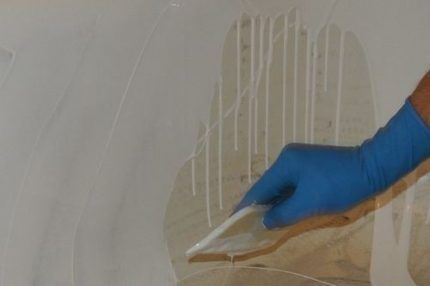
Inspect the walls, look for errors - somewhere you touched the applied coating, or a drip formed due to a lack of liquid material. Using a spatula, coat the defective areas with acrylic in a volume that allows it to flow to the bottom. Then all errors will be leveled out.
The fourth stage - coating the bottom with acrylic
There is enough liquid material here - it has dripped from the walls and is poured from the jar. Using a spatula, level the acrylic coating along the bottom, making sure the layer is uniform by eye. Proceed carefully, not catching the sectors of the transition of the bottom into the walls. Now excess enamel may flow down the drain, do not prevent this.
Gravity will force the liquid acrylic to flow to the bottom, but the layer itself will be uneven. Using light movements of the spatula, you need to visually level the enamel coating
To fully level the enamel layer, run the edge of the spatula along the surface of the bottom - draw a lattice with it. Then leave the bath alone for 15 minutes and the acrylic coating will level off by itself.
All that remains is to use a spatula to collect drops of acrylic hanging from the lower edge of the side. Move the spatula carefully, without catching the main plane of the bathtub side. Wait 10-15 minutes - drops may form again.
How to dry a free-flowing bathtub
The acrylic coating hardens gradually, more and more every hour. While meticulously examining the results of enamel pouring, workers sometimes notice small defects and try to erase them with acrylic from neighboring areas. You can't do that!
That's it, the enamel has already hardened enough and any touch to it will only make it worse. Wait for preliminary drying (polymerization), then use the factory repair kit.
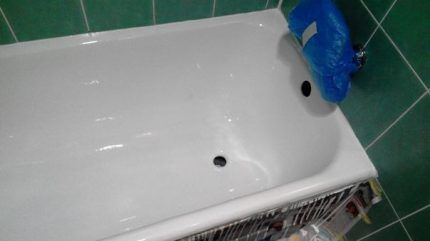
After 48 hours from the moment the acrylic composition is applied to the surface of the sanitary container, its preliminary polymerization will occur.
Until this time, no one - neither you yourself, nor other household members, nor pets - should enter the bathroom. Otherwise, every speck of dust, every hair brought in by the air flow through the open door will stick and spoil the appearance of the freshly painted bowl.
To avoid spreading pollutants through the air, do not touch newspapers with acrylic stains placed on the floor. It is safer to remove them later, after waiting for 48 hours of polymerization.
It's time to install the harness
The new enamel layer is completely dry, there is no need to wait any longer. Place drain-overflow piping, having first removed the acrylic accumulator and cut off dry streaks with a wallpaper knife. Before assembly, check the suitability of the gaskets on the harness - if they have lost flexibility, lubricate them with sealant before work.
Having installed the drain and overflow, twist the drain pipe to its previous position - the inlet hole is turned “to the bathtub” horizontally. Connect the harness to it, remove the protective film from the mixer and turn on the water - you need to make sure that the drain does not leak. That's all, the bathtub is repaired and ready for use.
In order for your plumbing fixtures to remain attractive longer, you must adhere to basic rules for caring for the coating and choose the right one. bath cleaner.
It should be noted that bowls with cracks cannot be restored. Therefore it will be necessary choose a new bath and carry out its installation.
Conclusions and useful video on the topic
Enameling a bowl with acrylic that was previously painted with another enamel and requires puttying of individual areas:
Video instructions for restoring the finishing of a bathtub with liquid acrylic from the manufacturer of restoration compositions "Plastol":
The following video describes the process of installing the trim, which was dismantled before applying acrylic enamel:
Following the instructions in the article, you will restore the enamel coating of the bathtub yourself. The updated container will last as long as it was carefully repaired.
Please note that self-leveling acrylic finishes require careful cleaning. You cannot use abrasive products, only liquid ones; substances containing a solvent are also not suitable.
Share with readers your experience in restoring an old cast iron bathtub. Please leave comments on the article, ask questions that interest you, participate in discussions and attach photos of your updated plumbing. The feedback form is located below.




The bathtub has already served us faithfully for about ten years. And just recently, unfortunately, I noticed damage to the enamel on it. I wanted to buy a new one, but you read interesting ways to bring old plumbing fixtures back to life.The methods are simple, you can do everything at home yourself, and it’s much cheaper than buying a new bathtub, especially since the current prices for plumbing equipment are not very conducive to an extraordinary purchase.
I have long dreamed of restoring a bathtub at home, but companies specializing in this matter charge from 5 to 7 thousand rubles. Let's say right away that the service is not cheap. Now I’m more likely to decide to update the bathtub myself. I saw glass in most hardware stores in the city. The only question: when leveling the layer on the side walls, a spatula is used - is it silicone or rubber?
A rubber spatula, small and medium in size, is used for leveling acrylic. In principle, a durable brush will also be suitable for this purpose. But I still recommend using a spatula.
Hello. The master restored our bathtub very poorly with liquid acrylic: he did not putty the deep chips around the drain hole, he filled the sides unevenly, leaving voids between the wall and the side.
Is it possible to use a repair kit to eliminate these defects or is it better to refill the bathroom? And if you do refill it, do you need to remove the acrylic coating made by the master (it’s only three days old), or can you sand it and fill it over it?
Hello, Ekaterina. Start by filing a claim with the professional who did the restoration of your bathtub. It is his responsibility to do his job efficiently! If you have estimates and receipts, it will be easier to put pressure on you.
As for pouring, it must be done immediately, in one fell swoop, so that the acrylic lays down evenly. If you are correcting defects, then the place needs to be prepared: cleaned, degreased and covered with special tape. After this, acrylic is applied and it dries for at least 16 hours. But still, in the end, the difference in color will be noticeable after such work.
Good afternoon
A cat walked along the side of the freshly filled bath (about 6 hours later).
Llama marks (dents) remain.
The idea arose to paint over the side with acrylic, using a brush to soften the transition, making it smooth (without a clear boundary).
The question is, will it last? or Board and transition down are weak points for such manipulations.
Same question. Is it possible to mix part of the acrylic from the jar and part of the hardener (and leave the rest “in reserve”